Spondon Level Crossing was a unique job that Haigh Rail recently undertook on behalf of partner Siemens Rail Automation. The works consisted of a full level crossing deck renewal, plus realignment of the existing footprint to accommodate a new alignment of the highway.
The existing track condition had to be scoped in advance of the works to assess the condition of the track components below the existing level crossing units. Haigh Rail determined that there were defective sleepers within the existing level crossing footprint, which had to be changed prior to the new level crossing being installed. Existing Hollow bearers also needed repositioning and there were existing drainage catchpits that required removing as they fell within new footprint of the level crossing. All sleepers throughout the crossing also needed respacing to enable new crossing panels to be housed.
During the project, Haigh Rail liaised with other stakeholders to allow for the setting out and installation of new kerb lines, as well as the resurfacing works that were required to each side of the crossing. This required good cooperation and interface management, so that all activities could be fully integrated.
Existing power cables also ran parallel to the dig area which needed to be excavated for the new edge beams, which made digging trenches challenging. However by working carefully and diligently these works were achieved without incident or accident.
Haigh Rail used road rail vehicles to lift the edge beams into place and throughout the works, track levels were monitored by the team to ensure the track geometry was not affected by the works.
Dan Foster, Engineering Director, had this to say:
“I am delighted to say that all Level Crossing components were installed safely and within the allocated time. Despite the challenges, Haigh Rail’s solution based approach allowed us to overcome these obstacles, by using our highly skilled in-house Project Engineers and Planners.
“By holding full-time managers, supervisors and multi-skilled and experienced operatives in-house, this enables multi-disciplinary projects like level-crossings to be a highly collaborative experience for all concerned – the client, project stakeholders and all our staff.”

